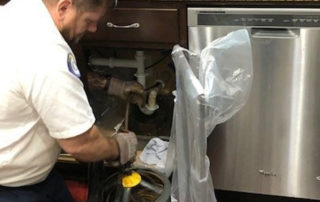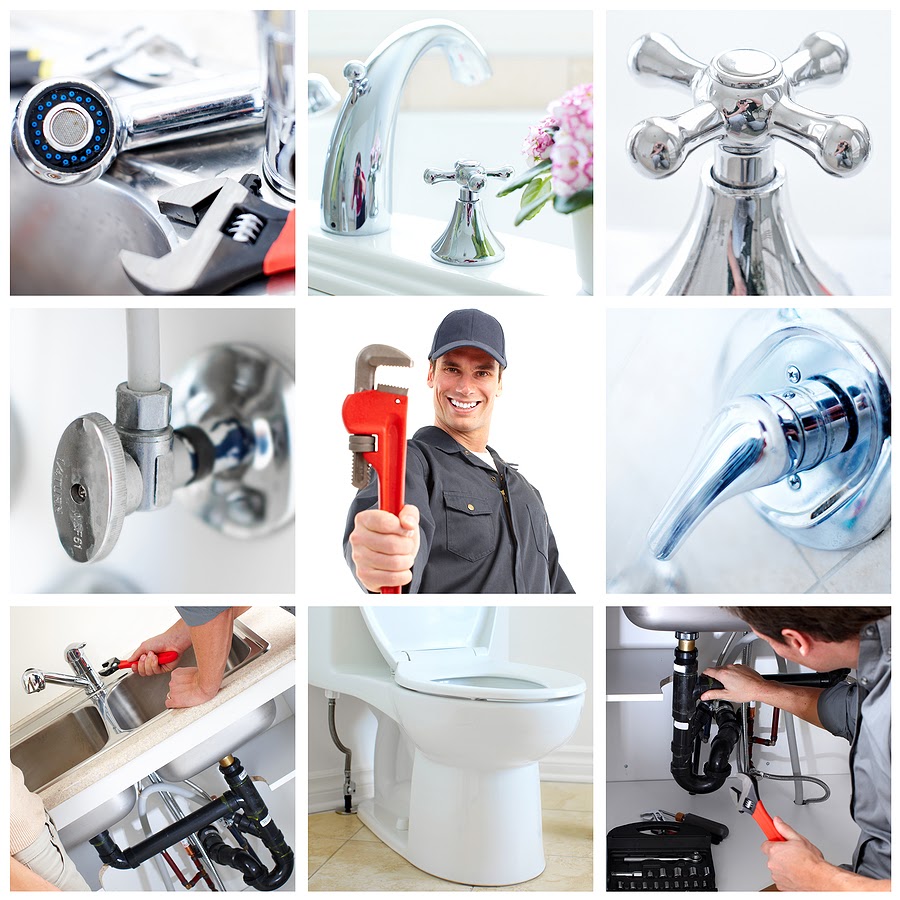Plumbing issues are a common headache for homeowners. They can disrupt daily life and cause damage.
Understanding these problems helps prevent bigger issues later on. Plumbing problems can range from minor annoyances to major disruptions. Dripping faucets, clogged drains, and running toilets are just a few examples. These issues are not only annoying but can also lead to higher water bills and potential damage.
Addressing them promptly is crucial. In this post, we will explore five common plumbing problems and how we fix them. Whether it’s a simple fix or requires a professional touch, knowing what to expect can save you time and stress. Stay tuned to learn more about these common plumbing issues and our effective solutions.

Credit: justcallburton.com
Leaky Faucets
Leaky faucets are a common household problem. They can be annoying and waste a lot of water. Fixing a leaky faucet may seem simple, but it often requires specific knowledge and tools. In this section, we’ll explore the causes of leaky faucets and the techniques to repair them effectively.
Causes Of Leaks
Several factors can cause a faucet to leak. Worn-out washers are a frequent culprit. These small parts can wear out over time, leading to drips. Another common cause is a loose or damaged O-ring. This small rubber ring helps seal the faucet and can deteriorate.
Corrosion inside the valve seat can also cause leaks. Mineral deposits can build up, causing the valve seat to corrode and leak. Lastly, improper installation can be a cause. If a faucet is not installed correctly, it may start leaking soon after.
Repair Techniques
Different methods can fix a leaky faucet. One of the most common ways is to replace the washers. This simple fix often stops the leak. To do this, turn off the water supply and remove the faucet handle. Replace the old washers with new ones.
If the O-ring is the problem, replacing it can solve the issue. Remove the faucet handle and replace the damaged O-ring with a new one. This can stop the leak and restore the faucet’s function.
For corrosion in the valve seat, cleaning or replacing the valve seat may be necessary. Use a valve seat wrench to remove the old valve seat. Then, clean the area and install a new valve seat. This can help stop the leak and ensure the faucet works properly.
Finally, checking the installation of the faucet can prevent leaks. Make sure all parts are tightened correctly and that no components are missing. Proper installation can help avoid future leaks and save water.

Credit: www.showplumbing.com
Clogged Drains
Clogged drains are a common household issue. They can cause major headaches. Water backs up. Bad odors fill the room. It disrupts daily life. But don’t worry. We can fix clogged drains. Let’s see how to identify and clean blockages.
Identifying Blockages
First, we need to identify the blockage. Slow draining water is a sign. Listen for gurgling sounds. Smell for foul odors. These are clues. The blockage could be in the sink, tub, or toilet. Sometimes, more than one drain gets clogged. This means the blockage is in the main sewer line. Identifying the problem helps us fix it faster.
Drain Cleaning Methods
There are several ways to clean drains. We use a plunger for minor clogs. It’s simple and effective. Plunging creates pressure. This forces the blockage through the pipe. If the plunger doesn’t work, we try a drain snake. A snake is a long, flexible tool. It reaches deep into the pipe. It breaks up or pulls out the blockage.
For stubborn clogs, we use hydro jetting. This method uses high-pressure water. It blasts through the blockage. It also cleans the pipe walls. This prevents future clogs. Sometimes, we use chemical drain cleaners. But we are cautious. Chemicals can damage pipes. We prefer natural solutions. Baking soda and vinegar work well. They are safe and effective. Each method has its place. We choose the best one for the job.
Running Toilets
Have you ever heard that annoying sound of water continuously running in your toilet tank? It’s like the sound of money being flushed down the drain! Running toilets are not only irritating but also wasteful and can cause a spike in your water bill. Let’s dive into why this happens and how we can fix it.
Common Issues
Running toilets usually boil down to a few common issues:
- Faulty Flapper: The flapper is the rubber valve at the bottom of the tank. If it’s worn out, water leaks and the tank can’t fill properly.
- Chain Problems: If the chain connecting the flapper to the handle is too short or tangled, it won’t close the flapper correctly.
- Float Issues: The float regulates the water level in the tank. If it’s set too high or too low, it can cause the toilet to run constantly.
Fixing Toilet Mechanisms
Fixing a running toilet can be simple if you know what to look for. Here’s a quick guide:
- Check the Flapper: Open the tank and inspect the flapper. If it looks worn or damaged, replace it with a new one.
- Adjust the Chain: Make sure the chain has some slack but isn’t too loose. You might need to adjust the length or untangle it.
- Set the Float: The float can be adjusted by bending the arm or turning the screw. Ensure it’s set to the appropriate water level to prevent overflow.
Still having trouble? Don’t fret! Our professional plumbers are just a call away. With years of experience, we can diagnose and fix the problem quickly. Running toilets are a nuisance, but with the right approach, they can be handled efficiently.
Remember, a running toilet is more than just an annoyance—it’s a potential drain on your wallet and the environment. So, next time you hear that telltale sound, take action!
Low Water Pressure
Low water pressure can be frustrating. It makes daily tasks like showering and washing dishes difficult. Several factors can cause low water pressure. Understanding and addressing these factors can improve your water flow significantly.
Pressure Problems
One common cause of low water pressure is clogged pipes. Over time, mineral deposits can build up inside pipes. This buildup restricts water flow, leading to decreased pressure. Another common cause is leaks. Even a small leak can reduce water pressure significantly. Checking for leaks and fixing them can restore normal pressure.
Improving Water Flow
To improve water flow, regular maintenance is key. Cleaning aerators and showerheads can remove blockages. Replacing old, corroded pipes can also help. If you live in an area with hard water, consider installing a water softener. Soft water can reduce mineral buildup in your pipes, improving water flow.
Another effective solution is adjusting the pressure regulator. Many homes have a pressure regulator installed where the main water line enters the house. Adjusting this regulator can increase water pressure. Sometimes, the municipal water supply is the issue. In such cases, installing a booster pump can help increase water pressure.
Water Heater Issues
Water heaters are essential in our homes. They provide us with the hot water we need for showers, washing dishes, and doing laundry. But like all appliances, water heaters can run into issues. When they do, it can be a real headache. Let’s dive into some common signs that your water heater might be in trouble and how we can fix them.
Signs Of Trouble
Wondering if your water heater is on the fritz? Here are a few telltale signs:
- No Hot Water: If you’re only getting cold water, your heater might be broken.
- Strange Noises: Popping or rumbling sounds are a red flag.
- Water Leaks: Puddles around the heater indicate trouble.
- Discolored Water: Rusty or murky water is a sign of corrosion inside the tank.
- Inconsistent Temperature: If the water temperature fluctuates, your heater could be failing.
Heater Repair Solutions
So, what can we do to fix these issues? Here are some solutions:
- Thermostat Adjustment: Sometimes, a simple adjustment of the thermostat can solve the problem.
- Flushing the Tank: Sediment build-up can cause noises and inefficiency. Flushing the tank removes this debris.
- Replacing the Heating Element: If there’s no hot water, the heating element might be faulty and need replacement.
- Fixing Leaks: Leaks can often be repaired by tightening connections or replacing faulty parts.
- Professional Inspection: When in doubt, it’s always best to call a professional for a thorough inspection and repair.
Remember, regular maintenance can prevent many of these issues. If you notice any signs of trouble, don’t hesitate to reach out. After all, who wants to take a cold shower on a chilly morning?
Have you had any quirky experiences with your water heater? Share your stories in the comments below!
Preventive Maintenance
Preventive maintenance is the best way to avoid common plumbing problems. Regular care ensures your plumbing system stays efficient and trouble-free. Here, we will discuss regular inspections and some DIY tips.
Regular Inspections
Regular inspections can catch issues before they become big problems. Check your pipes, faucets, and fixtures for leaks. Look under sinks and around toilets. A small leak can lead to big damage. Inspect your water heater. Rust or puddles around the base are signs of trouble. Regularly check your drains. Slow drainage can signal a clog forming. Always listen for strange noises in your plumbing. Gurgling sounds can indicate a problem. These simple checks can save you from expensive repairs.
Diy Tips
There are simple things you can do yourself. Use a plunger to clear minor clogs. Always have one for your sink and toilet. Use a drain snake for tougher clogs. Pour boiling water down your drains to clear grease and soap buildup. Install drain covers to catch hair and debris. Check and replace washers in dripping faucets. A new washer can stop leaks. Regularly clean your showerheads. Soak them in vinegar to remove mineral deposits. These tips can help you keep your plumbing in good shape.
Choosing The Right Plumber
When faced with a plumbing issue, picking the right plumber can be daunting. It’s a task that requires careful consideration, as the wrong choice can lead to more problems down the line. To simplify this process, we’ve broken down the key factors to consider. Let’s dive into the qualities you should look for and the questions you should ask a potential plumber.
Qualities To Look For
Choosing the right plumber is critical. Here are some qualities that should be on your checklist:
- Experience: Seasoned plumbers have seen it all and can handle any problem.
- Licensing and Certification: A licensed plumber ensures they meet the industry standards.
- Reliability: You need someone who shows up on time and completes the job efficiently.
- Good Reviews: Positive feedback from previous clients is a great sign.
- Insurance: This protects you in case of accidental damage during the repair.
Questions To Ask
Before hiring a plumber, it’s crucial to ask the right questions. Here are some to consider:
- Are you licensed? Ensure they have the necessary credentials.
- Do you have insurance? This covers any potential damage during the repair.
- What is your experience? Knowing their experience level can give you peace of mind. <liCan you provide references? Speaking to previous clients can give insights into their work quality.
- What are your rates? Understanding their pricing helps avoid surprises later.
Choosing the right plumber doesn’t have to be stressful. By focusing on these qualities and asking the right questions, you can find a reliable professional who will get the job done right. After all, a good plumber is worth their weight in gold!
Emergency Plumbing Services
We all know the feeling—it’s late at night, and suddenly, there’s water everywhere. Panic sets in, and you wonder who to call. Emergency plumbing services are here to save the day (or night). But when exactly should you call, and what can you expect? Let’s dive into the details.
When To Call
Knowing when to call for emergency plumbing services can save you a lot of headaches. Here are some situations that definitely warrant a call:
- Burst pipes: If you notice water gushing out uncontrollably, it’s time to pick up the phone.
- Flooding: Whether it’s from a broken pipe or severe weather, flooding needs immediate attention.
- No hot water: Especially in winter, no hot water is more than just an inconvenience.
- Clogged drains: If plunging doesn’t work and water isn’t draining, call the pros.
- Gas leaks: This is a life-threatening emergency. If you smell gas, leave your home and call a plumber.
What To Expect
Once you’ve made the call, what happens next? Here’s a brief rundown of what you can expect:
- Quick Response: Emergency plumbers are available 24/7. They aim to be at your doorstep as soon as possible.
- Assessment: Upon arrival, the plumber will assess the situation to understand the problem’s extent.
- Temporary Fix: If it’s a major issue, they might implement a temporary fix to stop further damage.
- Permanent Solution: Once things are under control, they’ll work on a permanent solution to fix the issue.
- Cost Estimate: Before any major work, you’ll receive a cost estimate so there are no surprises.
Emergency plumbing services are like the cavalry arriving in the nick of time. They tackle the problem head-on, ensuring your home is safe and dry. So, when in doubt, don’t hesitate to call!

Credit: www.schulerservice.com
Frequently Asked Questions
What Is The Most Common Plumbing Repair?
The most common plumbing repair is fixing leaky faucets. This issue can waste water and increase bills.
What Is One Of The Most Common Problems With Pipes?
A common problem with pipes is clogging. Debris, grease, or hair can build up, causing blockages. Regular maintenance helps prevent this.
What Is An Example Of A Plumbing Problem?
A common plumbing problem is a leaking faucet. It wastes water and increases your utility bills.
What Do Plumbers Usually Fix?
Plumbers usually fix leaks, clogged drains, broken pipes, faulty water heaters, and malfunctioning toilets. They also install fixtures and repair sewer lines.
Conclusion
Dealing with plumbing problems can be stressful. But knowing the common issues helps. Our expert team handles leaks, clogs, and other plumbing troubles swiftly. Regular maintenance prevents many of these problems. Trust our reliable service for a hassle-free solution. Enjoy peace of mind with your plumbing in good hands.
Contact us for any plumbing needs or advice. Stay worry-free and keep your home running smoothly.

